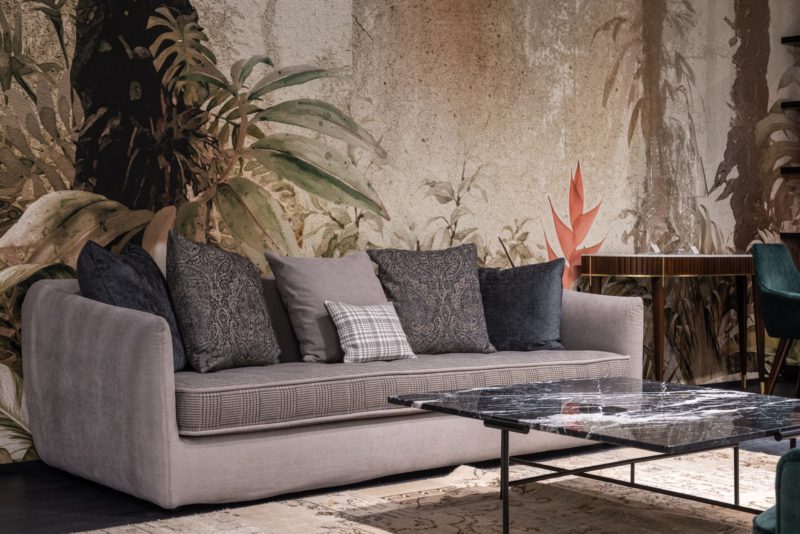When measuring in a customer’s house, be sure to note your widths and heights to verify you’re cutting the parts correctly. Also, when railroading your fabric, keep in mind that the height cut should be selvage to selvage, not up the roll. So, how to sew a loveseat slipcover?
Slipcover
A slipcover is a fitting protective cover for upholstered furniture that you can slide on and off. Typically, slipcovers are composed of cloth. Slipcovers are easy to put on and take off, and you may remove them for seasonal changes, cleaning, or storage.

Slipcovers are sometimes referred to as “furniture clothing.” They’re tailored in the same way clothing is and are fitted loosely or snugly according to the tailor’s preferences. Some individuals purchase furniture with basic muslin upholstery just know how to select the right slipcover for you.
How To Sew A Loveseat Slipcover?
When learning how to sew a loveseat slipcover, here are some steps you can take. But first, you need to be careful in measuring your piece of furniture accurately can save you time and money. You can do this by preventing buying extra fabric or making unnecessary journeys to your client’s home. Likewise, when looking at your artwork, look for the largest area in the portion you’re working on.
The top of the cut is generally the most prominent place for an outside back and outside arms. When measuring, keep in mind that the top of the outer arm extends farther back than the bottom. But the lower front of the outside arm extends farther back than the top.
Take your time and make sure you get these measurements just perfect the first time. Then, allow your individuality to show through in your design. Create features that make your slipcover appear unique. This is a crucial step on how to sew a loveseat slipcover.
Do it rather than like it came from a large box store to add your flair or personality to it. One approach to achieve this is to utilize a different form of closure, such as a zipper, velcro, ties, or buttons. This blue parsons chair slipcover exemplifies this.
I used the turn cord as the buttonhole and added button embellishments. Skirts are another way to take your slipcover to the next level. I like self-lining the skirts because they drape better, and the cloth behaves uniformly when the slipcovers are cleaned.
The same idea applies when self-decking your slipcovers; a decking fabric will react differently than your primary fabric. When sewing the skirt for my rolling arm club chair slipcover. I wanted to add a quirky element that gives my covering a bit more of my personality.
What should I do if my cushion doesn’t fit properly?
Are you able to design a pattern for your cushion? For both upholstery and slipcovers, getting the correct cushion fit is critical. A cushion cover that isn’t quite correct is the most distracting item to look at.
You’ve put so much effort into your project; what happened to my cushion? Don’t worry; using my tried and proper methods for a perfect pillow every time, we’ll get you past this barrier! Yes, you are capable of doing this task.
Take precise measurements of your furniture and transfer those measurements to make a design. I make my templates out of muslin fabric. As a result, it is easier to shape the seating area of my products.
What kind of slipcover fabric should I use?
For slipcovers, I like cotton twill or denim. These materials tend to last a long time; you may wash them if they want to, as long as it’s not dried. Although I like a 12 oz cloth, there are several very excellent 10 oz materials available.
I chose a fabric from Big Duck Canvas for the rolled arm club chair covering. It’s their 12 oz., preshrunk Bull Denim in lime green. The contrast cording is made of their fuchsia 10 oz.
Cotton Canvas. Both materials were fantastic to work with. The body and drape of the bull denim appealed to me.
Let’s pin our slipcover into place for a great fit!
You’ve measured your piece, thought of some exciting embellishments. Now it’s time to pin the fabric pieces together so you can sew your unique slipcover together. To begin, I secure my slipcovers to the furniture.
I mean by “anchoring” by using pins to hold my fabric pieces in place on the chair. It is so that I can get started. Start by pinning the essential parts together, such as the inner back, farthest back, and deck.
Now it’s time to work on the inner and outside arms. You may begin making your relief cuts once everything is secured and your parts are mostly put together. I know everything is in the proper location, and I won’t be short someplace.
It is because I pushed the fabric pieces too far in one way. It is by anchoring and pinning the significant pieces together before making my relief cuts. I made the same error and had to cut a new piece for your coverage as a result.
It’s time to make your covering!
Sewing is the following step once you’ve pinned all of your components together. Remove the pins as you stitch, and be careful since you are bound to stab yourself once or twice. So have some band-aids on hand!! I’m excited to see your slipcover creations.
Conclusion
So, how to sew a loveseat slipcover? There are a lot of cheap used slipcovers, but if it isn’t on your budget. Follow these easy steps to make yourself one!
